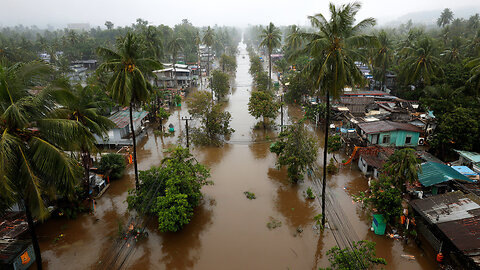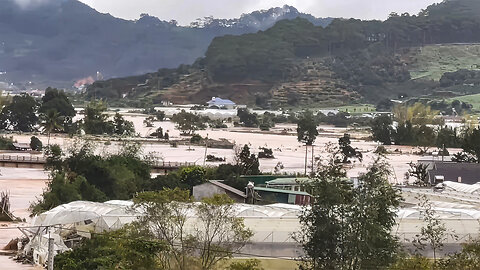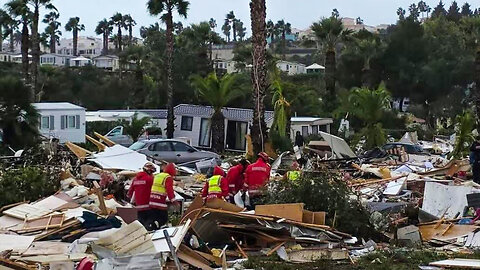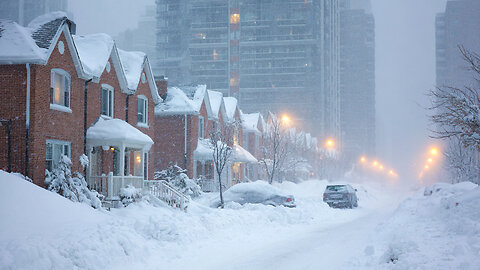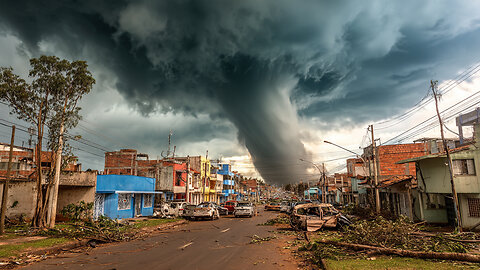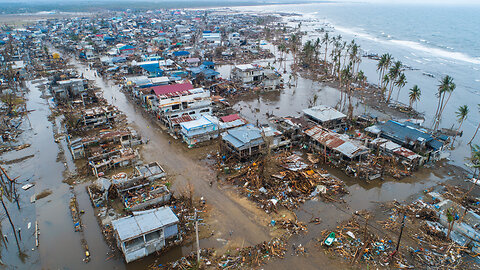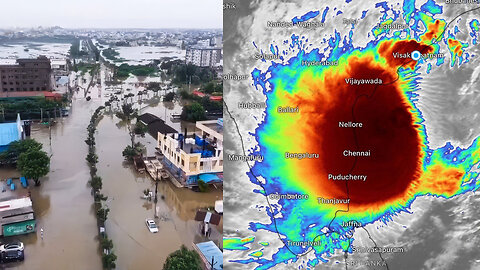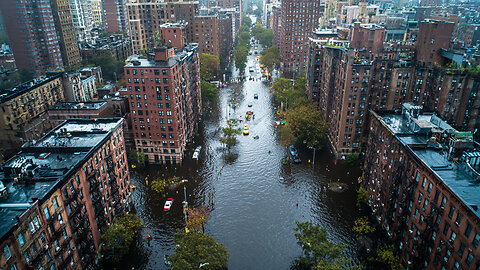-
Thailand Declares Emergency After Severe Flooding
 ALLATRAThe relentless torrential rains that struck southern Thailand led to a large-scale disaster in ten provinces at once. More than two million seven hundred thousand people were affected, and about forty-five thousand residents were forced to urgently evacuate. Due to the flooding of railway tracks, the state railway temporarily suspended train service in the southern direction, and hundreds of tourists found themselves blocked in hotels and at airports, unable to leave the disaster zone. On November 25th, a state of emergency was declared in the country. The army, helicopters, and even the only aircraft carrier in Thailand were deployed for rescue operations; together with a flotilla of fourteen boats, it was sent to assist the victims. The most severe situation developed in the Hat Yai district of Songkhla Province — the most powerful flood in the past twenty-five years occurred here. The city, which is a major business and tourist center, was hit by record rainfall: at Hat Yai Airport alone, within twenty-four hours — from the morning of November 21st to the morning of November 22nd — 14.7 inches of rain fell. The water level rose to eight point two feet. Many people spent several days on the roofs of their homes without water or food. Huge snakes were floating along the flooded city streets, adding even more terror to the chaos. The main hospital of Hat Yai was also submerged, where at that time there were six hundred patients, including fifty people in intensive care. Helicopters were used to deliver food, fuel for generators, and to carry out the emergency evacuation of critically ill patients. Thirty newborns were also in mortal danger when water flooded the two lower floors of the building. The rampaging elements claimed the lives of thirty-three people. Most of the victims drowned or died from electric shock. The cause of this flood was not a tropical cyclone, as is usually the case in the region, but a stationary low-pressure zone that triggered a rare and extremely dangerous phenomenon — the so-called “rain bomb,” when a colossal volume of precipitation falls within a short period of time, comparable in destructive force to a powerful hurricane. The development of events was predicted only two hours before the impact of the elements. Moreover, the main blow occurred late at night, when residents had practically no time for either preparation or evacuation. Such a catastrophic development of events, not only in tropical countries but throughout the entire world, had been forecast by scientists of the international scientific collective ALLATRA several decades ago. Unfortunately, at that time, the global public ignored this warning. And in the coming years, many scientifically grounded scenarios of what will happen with cataclysms on Earth were voiced. We invite you to read this report, as understanding what is happening can save your life. #ThailandFloods #HatYaiFlood #ThailandWeather #RainBomb #SevereFlooding #ExtremeWeather2025 #ClimateUpdate #DisasterNews #FloodRescue #SouthThailand13 views
ALLATRAThe relentless torrential rains that struck southern Thailand led to a large-scale disaster in ten provinces at once. More than two million seven hundred thousand people were affected, and about forty-five thousand residents were forced to urgently evacuate. Due to the flooding of railway tracks, the state railway temporarily suspended train service in the southern direction, and hundreds of tourists found themselves blocked in hotels and at airports, unable to leave the disaster zone. On November 25th, a state of emergency was declared in the country. The army, helicopters, and even the only aircraft carrier in Thailand were deployed for rescue operations; together with a flotilla of fourteen boats, it was sent to assist the victims. The most severe situation developed in the Hat Yai district of Songkhla Province — the most powerful flood in the past twenty-five years occurred here. The city, which is a major business and tourist center, was hit by record rainfall: at Hat Yai Airport alone, within twenty-four hours — from the morning of November 21st to the morning of November 22nd — 14.7 inches of rain fell. The water level rose to eight point two feet. Many people spent several days on the roofs of their homes without water or food. Huge snakes were floating along the flooded city streets, adding even more terror to the chaos. The main hospital of Hat Yai was also submerged, where at that time there were six hundred patients, including fifty people in intensive care. Helicopters were used to deliver food, fuel for generators, and to carry out the emergency evacuation of critically ill patients. Thirty newborns were also in mortal danger when water flooded the two lower floors of the building. The rampaging elements claimed the lives of thirty-three people. Most of the victims drowned or died from electric shock. The cause of this flood was not a tropical cyclone, as is usually the case in the region, but a stationary low-pressure zone that triggered a rare and extremely dangerous phenomenon — the so-called “rain bomb,” when a colossal volume of precipitation falls within a short period of time, comparable in destructive force to a powerful hurricane. The development of events was predicted only two hours before the impact of the elements. Moreover, the main blow occurred late at night, when residents had practically no time for either preparation or evacuation. Such a catastrophic development of events, not only in tropical countries but throughout the entire world, had been forecast by scientists of the international scientific collective ALLATRA several decades ago. Unfortunately, at that time, the global public ignored this warning. And in the coming years, many scientifically grounded scenarios of what will happen with cataclysms on Earth were voiced. We invite you to read this report, as understanding what is happening can save your life. #ThailandFloods #HatYaiFlood #ThailandWeather #RainBomb #SevereFlooding #ExtremeWeather2025 #ClimateUpdate #DisasterNews #FloodRescue #SouthThailand13 views -
Ethiopia Volcano Awakens After Thousands of Years | What Scientists Are Watching
 ALLATRAOn November 23, Ethiopia experienced a sudden and powerful eruption of the Haili-Gubbi volcano. The ash plume rose to an altitude of about nine miles, disrupting the air corridors connecting Africa, the Middle East, and South Asia. A “red code” aviation alert was issued immediately for the region, as also reported by the Toulouse Volcanic Ash Advisory Center. Satellite data obtained on November 24 revealed not only an extensive volcanic-ash plume but also a strong sulfur-dioxide release at altitudes ranging from about three miles to roughly eleven miles. These measurements clearly indicate major volcanic activity: the IASI-C satellites detected an SO₂ plume with a total mass of more than fifty-eight thousand short tons. The gas-and-ash plume persisted in the atmosphere for a long time after the eruption, gradually drifting over the Red Sea and moving toward Oman and Yemen. What makes this event especially remarkable is that Haili-Gubbi had no confirmed eruptions for nearly twelve thousand years; previously, the volcano exhibited only weak gas emissions. Its sudden awakening has become yet another indication of the growing geological activity on our planet. Dr. Egon Cholakian has outlined the fundamental changes in geodynamic catastrophes that await us in the coming years. We highly recommend watching his analysis. #EthiopiaVolcano #VolcanicEruption #BreakingNews #NaturalDisaster #ExtremeNature #GeologyUpdate #EarthActivity #GlobalWeather #DisasterNews #ScienceAlert47 views
ALLATRAOn November 23, Ethiopia experienced a sudden and powerful eruption of the Haili-Gubbi volcano. The ash plume rose to an altitude of about nine miles, disrupting the air corridors connecting Africa, the Middle East, and South Asia. A “red code” aviation alert was issued immediately for the region, as also reported by the Toulouse Volcanic Ash Advisory Center. Satellite data obtained on November 24 revealed not only an extensive volcanic-ash plume but also a strong sulfur-dioxide release at altitudes ranging from about three miles to roughly eleven miles. These measurements clearly indicate major volcanic activity: the IASI-C satellites detected an SO₂ plume with a total mass of more than fifty-eight thousand short tons. The gas-and-ash plume persisted in the atmosphere for a long time after the eruption, gradually drifting over the Red Sea and moving toward Oman and Yemen. What makes this event especially remarkable is that Haili-Gubbi had no confirmed eruptions for nearly twelve thousand years; previously, the volcano exhibited only weak gas emissions. Its sudden awakening has become yet another indication of the growing geological activity on our planet. Dr. Egon Cholakian has outlined the fundamental changes in geodynamic catastrophes that await us in the coming years. We highly recommend watching his analysis. #EthiopiaVolcano #VolcanicEruption #BreakingNews #NaturalDisaster #ExtremeNature #GeologyUpdate #EarthActivity #GlobalWeather #DisasterNews #ScienceAlert47 views -
Record Rainfall Triggers Massive Floods Across Vietnam
 ALLATRAUnprecedented floods have unfolded in South-Central Vietnam: the amount of rainfall has exceeded all historical norms. In less than 24 hours, major rivers broke decades-old records: the Dinh River surpassed the mark from 1986, the Kilo River exceeded the peak of 2009, and the Ba River broke the record from 1993. Local hydropower plants were forced to release water, which only increased the destructive power of the disaster. The situation was especially severe in Dak Lak Province, where in Son Hinh, from November 15th to November 21st, more than seventy-three inches of rainfall fell — an abnormal amount even for the rainy season. The water came so rapidly that people had to break through the roofs of their homes and climb onto them to escape the rising flood. Social media was filled with desperate pleas for help. Some families spent up to thirty hours on rooftops. In Dak Lak alone, sixty-three people died. Nationwide, the number of victims reached 98, and another ten people went missing, according to the Department of Dyke Management and Disaster Prevention as of November 26th. In Khanh Hoa Province, in Thai-Nha Trang, the water rose to between thirteen and sixteen feet. In Cat Tien District of Lam Dong Province, residents were completely cut off from the outside world, and authorities delivered food and essential supplies by boats and specialized equipment. The floods caused enormous damage to infrastructure and agriculture: nearly one point two million consumers were left without electricity, and two sections of national highways were closed due to landslides. More than four hundred houses were destroyed, over two thousand were damaged, and more than two hundred thousand were flooded. About two hundred twenty-two thousand acres of rice and other crops were destroyed, fish farms were wiped out, and about nine hundred twenty thousand head of livestock and poultry were lost. To handle the aftermath, the Ministry of Defense deployed more than forty-two thousand service members and more than one thousand two hundred units of equipment, including ships, boats, specialized vehicles, drones, generators, and pumps. The media are increasingly using terms such as record-breaking, abnormal, and historic to describe the floods, and experts explain this rapidly increasing abnormality of such events by warming and rising atmospheric humidity. But almost no one is taking into account one factor that is now making the rains truly extreme. Dr. Egon Cholakian explained this factor in detail in his video report. #VietnamFloods #BreakingWeather #ExtremeWeather #NaturalDisaster #FloodCrisis #ClimateUpdate #WeatherNews #DisasterReport #WorldNews #StormAlert51 views
ALLATRAUnprecedented floods have unfolded in South-Central Vietnam: the amount of rainfall has exceeded all historical norms. In less than 24 hours, major rivers broke decades-old records: the Dinh River surpassed the mark from 1986, the Kilo River exceeded the peak of 2009, and the Ba River broke the record from 1993. Local hydropower plants were forced to release water, which only increased the destructive power of the disaster. The situation was especially severe in Dak Lak Province, where in Son Hinh, from November 15th to November 21st, more than seventy-three inches of rainfall fell — an abnormal amount even for the rainy season. The water came so rapidly that people had to break through the roofs of their homes and climb onto them to escape the rising flood. Social media was filled with desperate pleas for help. Some families spent up to thirty hours on rooftops. In Dak Lak alone, sixty-three people died. Nationwide, the number of victims reached 98, and another ten people went missing, according to the Department of Dyke Management and Disaster Prevention as of November 26th. In Khanh Hoa Province, in Thai-Nha Trang, the water rose to between thirteen and sixteen feet. In Cat Tien District of Lam Dong Province, residents were completely cut off from the outside world, and authorities delivered food and essential supplies by boats and specialized equipment. The floods caused enormous damage to infrastructure and agriculture: nearly one point two million consumers were left without electricity, and two sections of national highways were closed due to landslides. More than four hundred houses were destroyed, over two thousand were damaged, and more than two hundred thousand were flooded. About two hundred twenty-two thousand acres of rice and other crops were destroyed, fish farms were wiped out, and about nine hundred twenty thousand head of livestock and poultry were lost. To handle the aftermath, the Ministry of Defense deployed more than forty-two thousand service members and more than one thousand two hundred units of equipment, including ships, boats, specialized vehicles, drones, generators, and pumps. The media are increasingly using terms such as record-breaking, abnormal, and historic to describe the floods, and experts explain this rapidly increasing abnormality of such events by warming and rising atmospheric humidity. But almost no one is taking into account one factor that is now making the rains truly extreme. Dr. Egon Cholakian explained this factor in detail in his video report. #VietnamFloods #BreakingWeather #ExtremeWeather #NaturalDisaster #FloodCrisis #ClimateUpdate #WeatherNews #DisasterReport #WorldNews #StormAlert51 views -
Storm Claudia Leaves a Trail of Chaos Across Portugal, Spain, France, Ireland and the UK
 ALLATRAThe storm “Claudia” developed from a broad area of low pressure that had already brought early cold weather and snowfall to eastern Canada and the northeastern United States in early November. As the system moved over the Atlantic, it strengthened, and after slowing down to the northwest of the Iberian Peninsula, it began accumulating enormous masses of warm, humid air. Beginning on November 11, the Spanish region of Galicia was hit. Within a single day, up to 5.9 inches of precipitation fell, and such volumes of water turned city streets into rushing torrents. Rivers, overwhelmed by the sudden inflow, began overflowing their banks, creating a flood threat for nearby settlements. In Portugal, “Claudia” struck with particularly destructive force. The most dramatic events unfolded in the popular tourist city of Albufeira, located in the southern region of the Algarve. It was here that a tornado formed in the morning: the vortex hit a hotel restaurant at the moment when several dozen people were having breakfast inside. The tornado’s destructive power left 28 people injured, including six children between the ages of two months and seven years. Four adults with serious injuries were hospitalized. The tornado also tore through a campsite, where a woman was killed while inside her motorhome when the storm struck. On November 15, another tornado hit the municipality of Silves, where several buildings were destroyed and two residents were left homeless. In Faro District, wind gusts reached approximately 69.6 miles per hour. Torrential downpours combined with hurricane-force winds toppled dozens of trees, damaged power lines, and caused widespread electricity outages. In the village of Azeitão, located in the municipality of Setúbal, a landslide collapsed a section of road. Traffic was completely blocked in both directions, significantly complicating the work of emergency services. In the town of Fernão Ferro, located near Lisbon, water levels rose so rapidly that during the night, it burst into the home of an elderly couple. They were unable to escape and drowned. The scale of the storm’s impact across the country was enormous: according to the National Authority for Emergency and Civil Protection (ANEPC), three thousand three hundred sixty-three incidents directly related to the severe weather were recorded throughout Portugal. As it moved farther north, “Claudia” reached the United Kingdom. In England and Wales, the situation was worsened by sudden flooding. In the town of Monmouth, nearly four point seven inches of rain fell overnight, exceeding the average monthly rainfall. The River Monnow breached its defensive structures, and on the morning of November 16, residents found most of the town submerged. In southern England, several railway lines were closed — both due to fallen trees on the tracks and the high water levels. Ireland fared no better. The counties of Wexford and Laois were hit hardest. A sharp rise in river levels led to the flooding of homes and businesses, and about five thousand people were left without electricity, according to ESB Networks. In France, however, the same storm produced a completely different yet no less unusual phenomenon. Due to an influx of warm subtropical air into the southwestern regions of the country, temperatures rose sharply. In one locality, a new November record was set — 85.6 degrees Fahrenheit, an entirely atypical value for this time of year. With each new natural disaster, we witness how its scale continues to grow, and more and more territories simultaneously fall under the destructive force of nature. Unfortunately, this is consistent with — and fully confirms — the mathematical model of the exponential growth of natural catastrophes on our planet that the scientific community of ALLATRA presented to the public several years ago. We invite you to familiarise yourself with these forecasts; they may save your life. #StormClaudia #IberiaStorm #PortugalTornado #SpainFloods #UKFlooding #IrelandStormDamage #ExtremeWeather2025 #EuropeanWeatherUpdate #NaturalDisasterNews #ClimateAnomalies28 views
ALLATRAThe storm “Claudia” developed from a broad area of low pressure that had already brought early cold weather and snowfall to eastern Canada and the northeastern United States in early November. As the system moved over the Atlantic, it strengthened, and after slowing down to the northwest of the Iberian Peninsula, it began accumulating enormous masses of warm, humid air. Beginning on November 11, the Spanish region of Galicia was hit. Within a single day, up to 5.9 inches of precipitation fell, and such volumes of water turned city streets into rushing torrents. Rivers, overwhelmed by the sudden inflow, began overflowing their banks, creating a flood threat for nearby settlements. In Portugal, “Claudia” struck with particularly destructive force. The most dramatic events unfolded in the popular tourist city of Albufeira, located in the southern region of the Algarve. It was here that a tornado formed in the morning: the vortex hit a hotel restaurant at the moment when several dozen people were having breakfast inside. The tornado’s destructive power left 28 people injured, including six children between the ages of two months and seven years. Four adults with serious injuries were hospitalized. The tornado also tore through a campsite, where a woman was killed while inside her motorhome when the storm struck. On November 15, another tornado hit the municipality of Silves, where several buildings were destroyed and two residents were left homeless. In Faro District, wind gusts reached approximately 69.6 miles per hour. Torrential downpours combined with hurricane-force winds toppled dozens of trees, damaged power lines, and caused widespread electricity outages. In the village of Azeitão, located in the municipality of Setúbal, a landslide collapsed a section of road. Traffic was completely blocked in both directions, significantly complicating the work of emergency services. In the town of Fernão Ferro, located near Lisbon, water levels rose so rapidly that during the night, it burst into the home of an elderly couple. They were unable to escape and drowned. The scale of the storm’s impact across the country was enormous: according to the National Authority for Emergency and Civil Protection (ANEPC), three thousand three hundred sixty-three incidents directly related to the severe weather were recorded throughout Portugal. As it moved farther north, “Claudia” reached the United Kingdom. In England and Wales, the situation was worsened by sudden flooding. In the town of Monmouth, nearly four point seven inches of rain fell overnight, exceeding the average monthly rainfall. The River Monnow breached its defensive structures, and on the morning of November 16, residents found most of the town submerged. In southern England, several railway lines were closed — both due to fallen trees on the tracks and the high water levels. Ireland fared no better. The counties of Wexford and Laois were hit hardest. A sharp rise in river levels led to the flooding of homes and businesses, and about five thousand people were left without electricity, according to ESB Networks. In France, however, the same storm produced a completely different yet no less unusual phenomenon. Due to an influx of warm subtropical air into the southwestern regions of the country, temperatures rose sharply. In one locality, a new November record was set — 85.6 degrees Fahrenheit, an entirely atypical value for this time of year. With each new natural disaster, we witness how its scale continues to grow, and more and more territories simultaneously fall under the destructive force of nature. Unfortunately, this is consistent with — and fully confirms — the mathematical model of the exponential growth of natural catastrophes on our planet that the scientific community of ALLATRA presented to the public several years ago. We invite you to familiarise yourself with these forecasts; they may save your life. #StormClaudia #IberiaStorm #PortugalTornado #SpainFloods #UKFlooding #IrelandStormDamage #ExtremeWeather2025 #EuropeanWeatherUpdate #NaturalDisasterNews #ClimateAnomalies28 views -
Historic Early Snowstorm Slams Canada & U.S. — Coldest November in Decades
 ALLATRAA rare and unusually early snowstorm struck southeastern Canada on November 9, 2025, covering the provinces of Quebec and Ontario. In southern Ontario, in Toronto — the country’s largest city — nearly four inches of snow fell on November 9. It was the earliest snowfall of this magnitude in more than half a century, since 1969. Normally, snow of this volume does not arrive here until December. And in nearby Hamilton, up to 6.5 inches of snow accumulated — the earliest snowfall there since 1962. Ontario police recorded hundreds of traffic incidents within 24 hours. In Quebec, some areas received up to 14 inches of snow overnight. The regions of Montérégie and Montreal were hit the hardest. Large numbers of fallen branches damaged power lines, leaving nearly four hundred thousand customers without electricity. Roads became covered with ice, causing serious accidents. Public works crews were clearing roughly 6,000 miles of streets and sidewalks. The storm front also brought Arctic cold into the United States. Across the Midwest and the Great Lakes region, up to 12 inches of snow fell over 2 days. Highways around Chicago, Illinois, were buried, and traffic was paralyzed — prompting the first winter weather warning there in almost 2 years. Snow also fell in Michigan, Indiana, Ohio, Pennsylvania, and New York, where cold air from Canada clashed with a warm flow over the Great Lakes, intensifying the snowfall. The cold wave then surged rapidly southward. By the morning of November 11, more than 190 million people across the United States were experiencing freezing temperatures. In Florida, Alabama, and Georgia, temperatures dropped 10 to 25 degrees Fahrenheit below normal, reaching 28 to 27 degrees Fahrenheit in some areas. Orlando saw only 37 degrees, while Jacksonville and Savannah dropped to 28 degrees, marking the coldest November morning since 1976. Even Miami cooled to 48 degrees, and residents witnessed iguanas falling from trees, stunned by the cold. Meteorologists explain that the cause was a powerful polar vortex pulling Arctic air from northern Canada and even from near the North Pole — almost three weeks before the official start of winter. Once again, we are witnessing anomalies and chaos in the natural processes of atmospheric circulation. Few people realize that one of the factors behind this planetary disruption — alongside rising temperatures — is micro- and nanoplastic pollution, with trillions of particles now filling Earth’s atmosphere. Learn more in the video: “Why Turbulence Is on the Rise? Egon Cholakian on Atmospheric Anomalies and Nanoplastic Pollution.” #CanadaSnowstorm #EarlyWinter2025 #NorthAmericaWeather #ArcticBlast #WinterStormUpdate #ExtremeWeather2025 #SnowstormNews #USColdWave #WeatherAnomalies #ClimateUpdate55 views
ALLATRAA rare and unusually early snowstorm struck southeastern Canada on November 9, 2025, covering the provinces of Quebec and Ontario. In southern Ontario, in Toronto — the country’s largest city — nearly four inches of snow fell on November 9. It was the earliest snowfall of this magnitude in more than half a century, since 1969. Normally, snow of this volume does not arrive here until December. And in nearby Hamilton, up to 6.5 inches of snow accumulated — the earliest snowfall there since 1962. Ontario police recorded hundreds of traffic incidents within 24 hours. In Quebec, some areas received up to 14 inches of snow overnight. The regions of Montérégie and Montreal were hit the hardest. Large numbers of fallen branches damaged power lines, leaving nearly four hundred thousand customers without electricity. Roads became covered with ice, causing serious accidents. Public works crews were clearing roughly 6,000 miles of streets and sidewalks. The storm front also brought Arctic cold into the United States. Across the Midwest and the Great Lakes region, up to 12 inches of snow fell over 2 days. Highways around Chicago, Illinois, were buried, and traffic was paralyzed — prompting the first winter weather warning there in almost 2 years. Snow also fell in Michigan, Indiana, Ohio, Pennsylvania, and New York, where cold air from Canada clashed with a warm flow over the Great Lakes, intensifying the snowfall. The cold wave then surged rapidly southward. By the morning of November 11, more than 190 million people across the United States were experiencing freezing temperatures. In Florida, Alabama, and Georgia, temperatures dropped 10 to 25 degrees Fahrenheit below normal, reaching 28 to 27 degrees Fahrenheit in some areas. Orlando saw only 37 degrees, while Jacksonville and Savannah dropped to 28 degrees, marking the coldest November morning since 1976. Even Miami cooled to 48 degrees, and residents witnessed iguanas falling from trees, stunned by the cold. Meteorologists explain that the cause was a powerful polar vortex pulling Arctic air from northern Canada and even from near the North Pole — almost three weeks before the official start of winter. Once again, we are witnessing anomalies and chaos in the natural processes of atmospheric circulation. Few people realize that one of the factors behind this planetary disruption — alongside rising temperatures — is micro- and nanoplastic pollution, with trillions of particles now filling Earth’s atmosphere. Learn more in the video: “Why Turbulence Is on the Rise? Egon Cholakian on Atmospheric Anomalies and Nanoplastic Pollution.” #CanadaSnowstorm #EarlyWinter2025 #NorthAmericaWeather #ArcticBlast #WinterStormUpdate #ExtremeWeather2025 #SnowstormNews #USColdWave #WeatherAnomalies #ClimateUpdate55 views -
Extreme Weather in Brazil: EF-4 Tornado and Major Storm Damage
 ALLATRAOn November 7, several states in Brazil were hit by powerful storm winds accompanied by heavy rain and hail, caused by an extratropical cyclone. The states most affected by the disaster were Rio Grande do Sul, Santa Catarina, and Paraná. In Porto Alegre, the capital of Rio Grande do Sul, wind gusts reached about 66 miles per hour. Around 800,000 people were left without electricity. In the municipality of Rolante, a young man died after being struck by a falling tree. In Passo Fundo, hurricane-force winds knocked down trees, brought down power lines, and shattered windows on the upper floors of buildings. Due to the full mobilization of fire and rescue services to deal with the storm’s aftermath, the graduation ceremony of the “Junior Firefighter” program was canceled. In addition to the strong winds, hail of medium and large size was reported in several areas. Heavy rainfall affected the central and northern regions of the state — in some places, more than six inches of rain fell in just 24 hours, exceeding the normal monthly average. In the Serra Gaúcha region, numerous landslides caused transportation disruptions and property damage. In Caxias do Sul, a landslide hit a residential house and four vehicles, but fortunately, no one was injured. The most tragic event occurred in the state of Paraná, where a powerful tornado destroyed up to 90% of the municipality of Rio Bonito do Iguaçu. Within just a few minutes, entire neighborhoods were reduced to rubble, and cars were tossed around like toys. The city looked like a war zone — no electricity, no water, no communication, while rescue teams worked for hours, searching through the debris. The disaster claimed the lives of 6 people — 5 in Rio Bonito do Iguaçu and one in nearby Guarapuava. Another 750 were injured, thirty of them seriously. A field hospital was deployed to provide medical assistance, and at least one thousand residents were left homeless. Temporary shelters were set up in nearby towns. Although the municipality was devastated, people did not lose hope: some helped their neighbors, others were simply grateful to be alive. Aid began arriving from neighboring cities, while volunteers and locals cleared the streets and collected debris. One survivor said, “The wind took everything except the will to live.” The scale of destruction forced authorities to declare a state of emergency in at least 14 cities of the state. Since Friday, 835 medical assistance requests have been recorded; 32 people remain hospitalized, 4 of them in intensive care. A preliminary assessment by MetSul Meteorologia indicated that the tornado reached Category Four on the Enhanced Fujita Scale (EF-4), with wind gusts estimated between 155 and 186 miles per hour. According to MetSul Meteorologia, the tornado in Rio Bonito do Iguaçu was one of the most powerful in the world this year and the most destructive in Brazil’s modern history. Field analyses and radar data confirmed that within the same storm system, three additional tornadoes formed in the neighboring state of Santa Catarina, causing significant damage in the municipalities of Dionísio Cerqueira, Xanxerê, and Faxinal dos Guedes. It is important to understand that the intensification of natural disasters began decades ago — what we are witnessing now is simply the visible phase of that process. Unusual weather phenomena, which have been occurring in various regions for several years, will continue to increase in both frequency and magnitude. To gain a deeper understanding of what is happening to our planet, we recommend watching the video address by Dr. Egon Cholakian. In it, he thoroughly explains the causes of these events, analyzes their consequences, shares forecasts for the future, and presents scientific approaches to possible solutions to this global problem. #BrazilStorms #BrazilTornado #ExtremeWeather2025 #RioBonitoDoIguacu #EF4Tornado #BrazilNews #SevereWeatherUpdate #ClimateEvents #StormDamage #NaturalDisasters59 views
ALLATRAOn November 7, several states in Brazil were hit by powerful storm winds accompanied by heavy rain and hail, caused by an extratropical cyclone. The states most affected by the disaster were Rio Grande do Sul, Santa Catarina, and Paraná. In Porto Alegre, the capital of Rio Grande do Sul, wind gusts reached about 66 miles per hour. Around 800,000 people were left without electricity. In the municipality of Rolante, a young man died after being struck by a falling tree. In Passo Fundo, hurricane-force winds knocked down trees, brought down power lines, and shattered windows on the upper floors of buildings. Due to the full mobilization of fire and rescue services to deal with the storm’s aftermath, the graduation ceremony of the “Junior Firefighter” program was canceled. In addition to the strong winds, hail of medium and large size was reported in several areas. Heavy rainfall affected the central and northern regions of the state — in some places, more than six inches of rain fell in just 24 hours, exceeding the normal monthly average. In the Serra Gaúcha region, numerous landslides caused transportation disruptions and property damage. In Caxias do Sul, a landslide hit a residential house and four vehicles, but fortunately, no one was injured. The most tragic event occurred in the state of Paraná, where a powerful tornado destroyed up to 90% of the municipality of Rio Bonito do Iguaçu. Within just a few minutes, entire neighborhoods were reduced to rubble, and cars were tossed around like toys. The city looked like a war zone — no electricity, no water, no communication, while rescue teams worked for hours, searching through the debris. The disaster claimed the lives of 6 people — 5 in Rio Bonito do Iguaçu and one in nearby Guarapuava. Another 750 were injured, thirty of them seriously. A field hospital was deployed to provide medical assistance, and at least one thousand residents were left homeless. Temporary shelters were set up in nearby towns. Although the municipality was devastated, people did not lose hope: some helped their neighbors, others were simply grateful to be alive. Aid began arriving from neighboring cities, while volunteers and locals cleared the streets and collected debris. One survivor said, “The wind took everything except the will to live.” The scale of destruction forced authorities to declare a state of emergency in at least 14 cities of the state. Since Friday, 835 medical assistance requests have been recorded; 32 people remain hospitalized, 4 of them in intensive care. A preliminary assessment by MetSul Meteorologia indicated that the tornado reached Category Four on the Enhanced Fujita Scale (EF-4), with wind gusts estimated between 155 and 186 miles per hour. According to MetSul Meteorologia, the tornado in Rio Bonito do Iguaçu was one of the most powerful in the world this year and the most destructive in Brazil’s modern history. Field analyses and radar data confirmed that within the same storm system, three additional tornadoes formed in the neighboring state of Santa Catarina, causing significant damage in the municipalities of Dionísio Cerqueira, Xanxerê, and Faxinal dos Guedes. It is important to understand that the intensification of natural disasters began decades ago — what we are witnessing now is simply the visible phase of that process. Unusual weather phenomena, which have been occurring in various regions for several years, will continue to increase in both frequency and magnitude. To gain a deeper understanding of what is happening to our planet, we recommend watching the video address by Dr. Egon Cholakian. In it, he thoroughly explains the causes of these events, analyzes their consequences, shares forecasts for the future, and presents scientific approaches to possible solutions to this global problem. #BrazilStorms #BrazilTornado #ExtremeWeather2025 #RioBonitoDoIguacu #EF4Tornado #BrazilNews #SevereWeatherUpdate #ClimateEvents #StormDamage #NaturalDisasters59 views -
Typhoon Kalmaegi (Tino) Hits Philippines and Vietnam: Severe Flooding and Landslides
 ALLATRAResidents of the Philippines had barely recovered from a series of natural disasters when the fierce Typhoon Kalmaegi, locally named Tino, struck the country. It hit the province of Cebu on November 4, bringing torrential rains, landslides, and catastrophic flooding. The PAGASA weather service recorded extreme rainfall: the city of Toledo received about sixteen and nine-tenths inches of rain in just one day — while the average monthly rainfall for Cebu in November is only about five and one-tenth inches. Most hydraulic structures in the region are designed to handle a maximum of about sixteen feet of water, with the strongest built for up to 33 feet. But the typhoon brought as much as 39 feet. Torrents of water rushed down from the mountains into residential areas, where drainage systems were either nonexistent or long incapable of coping with such loads. Poor neighborhoods with fragile infrastructure were completely washed away, and in some places, the water rose to more than ten feet. Locals shared that they had experienced typhoons before, but Kalmaegi was different — too strong. Once the water receded, the true scale of destruction became visible. People returned to the ruins, clearing layers of mud and debris, searching for anything that could still be salvaged. A week later, many districts of Cebu were still without running water. Major pipelines and artesian wells had been damaged, and recovery efforts were slow due to collapsed infrastructure. Although Kalmaegi was not the most powerful in terms of wind, its slow movement and enormous volumes of water made it deadly. Most of the victims drowned. Across the Philippines, two hundred thirty-two people were killed, one hundred twelve were reported missing, and five hundred thirty-two were injured. The typhoon then moved on to Vietnam, which was still recovering from devastating floods the previous week. On November 6, with wind speeds reaching up to one hundred fourteen miles per hour it struck the provinces of Dak Lak and Gia Lai. In just six hours, some areas received about thirteen and eight-tenths inches of rain. Powerful winds toppled trees, tore down walls, and left millions without electricity. The storm damaged nearly thirty thousand homes, three hundred twenty of which were completely destroyed. In Gia Lai Province, more than three hundred thousand people were evacuated — the largest operation in the region’s history. Thanks to these preventive measures, mass casualties were avoided, though the disaster still claimed five lives, and three people remained missing. Typhoons and other natural disasters are rapidly changing their behavior — a fact now recognized not only by scientists but also by ordinary people. More than ever, it is vital that emergency services take into account the new nature of these phenomena, and that everyone understands what is happening to our planet and how we can help mitigate the consequences. This is the message of Dr. Egon Cholakian in his video address.45 views
ALLATRAResidents of the Philippines had barely recovered from a series of natural disasters when the fierce Typhoon Kalmaegi, locally named Tino, struck the country. It hit the province of Cebu on November 4, bringing torrential rains, landslides, and catastrophic flooding. The PAGASA weather service recorded extreme rainfall: the city of Toledo received about sixteen and nine-tenths inches of rain in just one day — while the average monthly rainfall for Cebu in November is only about five and one-tenth inches. Most hydraulic structures in the region are designed to handle a maximum of about sixteen feet of water, with the strongest built for up to 33 feet. But the typhoon brought as much as 39 feet. Torrents of water rushed down from the mountains into residential areas, where drainage systems were either nonexistent or long incapable of coping with such loads. Poor neighborhoods with fragile infrastructure were completely washed away, and in some places, the water rose to more than ten feet. Locals shared that they had experienced typhoons before, but Kalmaegi was different — too strong. Once the water receded, the true scale of destruction became visible. People returned to the ruins, clearing layers of mud and debris, searching for anything that could still be salvaged. A week later, many districts of Cebu were still without running water. Major pipelines and artesian wells had been damaged, and recovery efforts were slow due to collapsed infrastructure. Although Kalmaegi was not the most powerful in terms of wind, its slow movement and enormous volumes of water made it deadly. Most of the victims drowned. Across the Philippines, two hundred thirty-two people were killed, one hundred twelve were reported missing, and five hundred thirty-two were injured. The typhoon then moved on to Vietnam, which was still recovering from devastating floods the previous week. On November 6, with wind speeds reaching up to one hundred fourteen miles per hour it struck the provinces of Dak Lak and Gia Lai. In just six hours, some areas received about thirteen and eight-tenths inches of rain. Powerful winds toppled trees, tore down walls, and left millions without electricity. The storm damaged nearly thirty thousand homes, three hundred twenty of which were completely destroyed. In Gia Lai Province, more than three hundred thousand people were evacuated — the largest operation in the region’s history. Thanks to these preventive measures, mass casualties were avoided, though the disaster still claimed five lives, and three people remained missing. Typhoons and other natural disasters are rapidly changing their behavior — a fact now recognized not only by scientists but also by ordinary people. More than ever, it is vital that emergency services take into account the new nature of these phenomena, and that everyone understands what is happening to our planet and how we can help mitigate the consequences. This is the message of Dr. Egon Cholakian in his video address.45 views -
Cyclone Monta Causes Chaos in India — Massive Floods, Two Million People Affected
 ALLATRAOn October 28, Tropical Cyclone “Monta”, with wind gusts reaching up to 68 miles per hour and torrential rainfall, struck the eastern coast of India. The states of Andhra Pradesh, Telangana, and Odisha were the hardest hit. Thanks to the early evacuation of tens of thousands of people from coastal areas, mass casualties were avoided, but the damage was immense. In Andhra Pradesh, which bore the brunt of the storm, three people lost their lives. The cyclone affected nearly two million residents. More than three thousand miles of roads and over three hundred bridges and culverts were damaged. Flights were canceled at three international airports in the state, and the South Central Railway suspended operations of at least one hundred twenty trains. The power grid suffered especially severe damage — strong winds toppled more than three thousand power poles, and over twenty-six thousand transformers were damaged. In East Godavari District, powerful waves destroyed fishermen’s homes, leaving entire villages homeless. Authorities set up more than one thousand four hundred temporary shelters, accommodating around one hundred thirty-six thousand people. About one hundred seventy-four thousand farmers suffered serious losses: fish farms, livestock operations, and poultry farms were flooded. More than two thousand two hundred head of livestock perished. The disaster completely destroyed around ninety-four thousand acres of farmland, and another three hundred forty-one thousand acres of crops — including rice, corn, bananas, cotton, and other produce — were submerged. In Prakasam District, about two hundred fifty workers were trapped inside tunnels of the Velugonda irrigation project, which channels water from the Krishna River to arid regions. After a canal burst, the tunnels were flooded for nearly six miles, but fortunately, everyone was safely evacuated. In fifteen districts of Odisha, more than eleven thousand people were evacuated. In Koraput District, over three hundred houses were destroyed. In mountainous areas, landslides and fallen trees blocked roads, cutting off access to remote villages. The state’s agriculture also suffered significant losses. Cotton and vegetable fields were flooded, threatening to leave thousands of families without harvests or income. In Telangana, as Cyclone Monta moved inland, it triggered abnormal downpours and flooding. At least six people died in the state. Among them was a woman swept away by floodwaters while trying to cross a submerged bridge despite her husband’s attempts to save her. In Warangal, a bedridden man drowned when water from flooded streets poured into his home. Floods destroyed roads, damaged power lines, and isolated entire regions. The Telangana State Groundwater and Disaster Prediction System described the floods as unprecedented. Such statements have become almost routine, as rainfall intensity continues to break records. Yet few specialists are aware — and even fewer have studied — that the intensity of rainfall is directly influenced by micro- and nanoparticles of plastic present in the atmosphere. You can learn more about how plastic is already affecting natural phenomena and the human body in the detailed interdisciplinary report “Nanoplastics in the Biosphere: From Molecular Impact to Planetary Crisis.”39 views 1 comment
ALLATRAOn October 28, Tropical Cyclone “Monta”, with wind gusts reaching up to 68 miles per hour and torrential rainfall, struck the eastern coast of India. The states of Andhra Pradesh, Telangana, and Odisha were the hardest hit. Thanks to the early evacuation of tens of thousands of people from coastal areas, mass casualties were avoided, but the damage was immense. In Andhra Pradesh, which bore the brunt of the storm, three people lost their lives. The cyclone affected nearly two million residents. More than three thousand miles of roads and over three hundred bridges and culverts were damaged. Flights were canceled at three international airports in the state, and the South Central Railway suspended operations of at least one hundred twenty trains. The power grid suffered especially severe damage — strong winds toppled more than three thousand power poles, and over twenty-six thousand transformers were damaged. In East Godavari District, powerful waves destroyed fishermen’s homes, leaving entire villages homeless. Authorities set up more than one thousand four hundred temporary shelters, accommodating around one hundred thirty-six thousand people. About one hundred seventy-four thousand farmers suffered serious losses: fish farms, livestock operations, and poultry farms were flooded. More than two thousand two hundred head of livestock perished. The disaster completely destroyed around ninety-four thousand acres of farmland, and another three hundred forty-one thousand acres of crops — including rice, corn, bananas, cotton, and other produce — were submerged. In Prakasam District, about two hundred fifty workers were trapped inside tunnels of the Velugonda irrigation project, which channels water from the Krishna River to arid regions. After a canal burst, the tunnels were flooded for nearly six miles, but fortunately, everyone was safely evacuated. In fifteen districts of Odisha, more than eleven thousand people were evacuated. In Koraput District, over three hundred houses were destroyed. In mountainous areas, landslides and fallen trees blocked roads, cutting off access to remote villages. The state’s agriculture also suffered significant losses. Cotton and vegetable fields were flooded, threatening to leave thousands of families without harvests or income. In Telangana, as Cyclone Monta moved inland, it triggered abnormal downpours and flooding. At least six people died in the state. Among them was a woman swept away by floodwaters while trying to cross a submerged bridge despite her husband’s attempts to save her. In Warangal, a bedridden man drowned when water from flooded streets poured into his home. Floods destroyed roads, damaged power lines, and isolated entire regions. The Telangana State Groundwater and Disaster Prediction System described the floods as unprecedented. Such statements have become almost routine, as rainfall intensity continues to break records. Yet few specialists are aware — and even fewer have studied — that the intensity of rainfall is directly influenced by micro- and nanoparticles of plastic present in the atmosphere. You can learn more about how plastic is already affecting natural phenomena and the human body in the detailed interdisciplinary report “Nanoplastics in the Biosphere: From Molecular Impact to Planetary Crisis.”39 views 1 comment -
Torrential Rain and Floods Hit New York and New Jersey — State of Emergency Declared
 ALLATRAOn October 30, a severe storm struck the northeastern United States, including the states of New York, New Jersey, and neighboring regions. Rain fell in sheets, and gusty winds intensified the destructive consequences. The city of New York was hit especially hard: the rain poured down suddenly. In some areas, up to one inch of precipitation fell in an hour, while in Central Park, one and eighty-three hundredths inches fell during the day, setting a record for this date in the past one hundred years. The city’s drainage system could not cope: streets, basements, and subway stations were flooded. In Brooklyn and Manhattan, two people died, trapped in basements that the swift flow of rainwater turned into deadly traps. New York emergency services received over eight hundred calls about flooding within a few hours. Crews cleared storm drains of leaves and debris, but water repeatedly clogged the system, causing new floods. Transportation was paralyzed. The subway was partially shut down. Three major airports in the New York region were severely affected, resulting in the cancellation of more than one thousand two hundred flights. Around fifteen thousand homes were left without electricity. Heavy rains also occurred in neighboring areas. On Long Island, about two and six tenths inches of precipitation fell, and in northern New Jersey, levels reached almost three and sixty-four hundredths inches in some places. Winds in the state were so strong that they tore two barges from their moorings and threw them ashore. Philadelphia was also affected: during the storm, a tree fell on a car, killing the driver. Experts note that such unusually powerful downpours were caused by a combination of a local cyclone and moist air brought from the Caribbean by Hurricane Melissa. The storm confirmed the obvious: extreme weather events are intensifying, and many cities and residents are unprepared. In this context, particular interest is drawn to the video message “Why Turbulence Is on the Rise? Egon Cholakian on Atmospheric Anomalies and Nanoplastic Pollution,” in which a representative of the international scientific group ALLATRA shared the findings of more than thirty years of research on atmospheric anomalies, space and geodynamic processes, and nanoplastic accumulation, as well as proposed specific measures to slow down the climate crisis.106 views 1 comment
ALLATRAOn October 30, a severe storm struck the northeastern United States, including the states of New York, New Jersey, and neighboring regions. Rain fell in sheets, and gusty winds intensified the destructive consequences. The city of New York was hit especially hard: the rain poured down suddenly. In some areas, up to one inch of precipitation fell in an hour, while in Central Park, one and eighty-three hundredths inches fell during the day, setting a record for this date in the past one hundred years. The city’s drainage system could not cope: streets, basements, and subway stations were flooded. In Brooklyn and Manhattan, two people died, trapped in basements that the swift flow of rainwater turned into deadly traps. New York emergency services received over eight hundred calls about flooding within a few hours. Crews cleared storm drains of leaves and debris, but water repeatedly clogged the system, causing new floods. Transportation was paralyzed. The subway was partially shut down. Three major airports in the New York region were severely affected, resulting in the cancellation of more than one thousand two hundred flights. Around fifteen thousand homes were left without electricity. Heavy rains also occurred in neighboring areas. On Long Island, about two and six tenths inches of precipitation fell, and in northern New Jersey, levels reached almost three and sixty-four hundredths inches in some places. Winds in the state were so strong that they tore two barges from their moorings and threw them ashore. Philadelphia was also affected: during the storm, a tree fell on a car, killing the driver. Experts note that such unusually powerful downpours were caused by a combination of a local cyclone and moist air brought from the Caribbean by Hurricane Melissa. The storm confirmed the obvious: extreme weather events are intensifying, and many cities and residents are unprepared. In this context, particular interest is drawn to the video message “Why Turbulence Is on the Rise? Egon Cholakian on Atmospheric Anomalies and Nanoplastic Pollution,” in which a representative of the international scientific group ALLATRA shared the findings of more than thirty years of research on atmospheric anomalies, space and geodynamic processes, and nanoplastic accumulation, as well as proposed specific measures to slow down the climate crisis.106 views 1 comment
